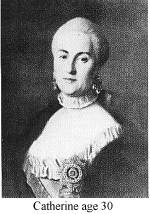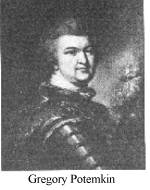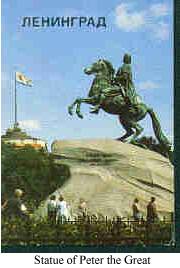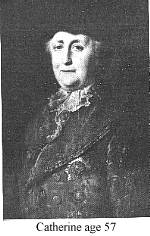



Not many people at European courts believed that Catherine would last long. Another German without a drop of Russian blood in her veins, and the true heir, Peter the Great's grandson murdered? Catherine herself knew how fragile her position really was. She kept the statesmen who had been active under Empress Elizabeth and under Peter. She even kept Chancellor Vorontzov. Nikita Panin was put in charge of foreign affairs.
When Catherine met the Senate for the first time at the Summer Palace, she was stunned by the realities of the country's financial and social situation. The chief portion of the army was still abroad and had not been paid for eight months. She wrote: "The fleet was abandoned, the army in disarray, the forts crumbling...". The budget showed a deficit of 17 million rubles, in a country of only 100 million people. No one knew what the revenues of the treasury were. Everywhere people complained about corruption, extortion and injustice. "How many towns are there in Russia?" she asked the Senate. No one knew. She suggested looking at the map. There was no map. Catherine took 5 rubles from her purse and sent a clerk to the Academy of Sciences to buy the latest map of Russia. The clerk returned and the towns were counted. At that moment Catherine left the sheltered world of a civilized court and stepped into Russia as it was: ignorant, superstitious, disorganized, unruly, often diseased and to a European appallingly backward. She decided to concentrate on increasing Russia's wealth, and as Russia was primarily agricultural, she began with the land. But first she had herself crowned on Sunday, September 22 in the old Assumption Cathedral in the heart of Moscow's Kremlin. The Archbishop of Novgorod celebrated the mass with her.
After her return to St. Petersburg, she turned to the affairs of state. She worked relentlessly from early morning to late at night. She decided that the overriding task would be to improve techniques in the agricultural regions. She sent experts to study the soil and propose suitable crops. She made grants to landowners to learn the ways which were being devised in England, and to buy machines that were being invented there. She encouraged introduction of modern methods to breed sheep and cattle, and she promoted horse-breeding. To work the under populated areas, she saw that more workers were needed. Catherine turned to advertisements in foreign newspapers, mostly German, inviting settlers and offering attractive terms. The response was excellent. Thousands took to the road Catherine and her mother had traveled twenty years before.
Next she turned to mining and sent geologists to access the ores from Russia's seemingly barren lands. She founded the first School of Mines in St. Petersburg, complete with an underground mine, where trainees could learn the trade under realistic conditions. She also paid special attention to the mining of silver. Furs had long been a resource of Russian wealth and she encouraged the existing trade in Siberia. As early as 1762 she decreed that anyone could start a new factory, except in the two capitals, which were overcrowded. Soon, enterprising state peasants were running large textile plants. A whole range of industries began to emerge: linen, pottery, leather goods and furniture. Here she also called on experts from abroad to help set up more sophisticated ventures. She turned mostly to England. She brought over Admiral Knowles to build warships and dockyards. Workmen from the Tula steelworks were sent to England to study the making of barometers, thermometers and mathematical instruments. Catherine founded factories for textiles outside the Moscow region, for linen in the area of Yaroslov and for leather and candles in the central Volga region. The total number of factories during her reign was increased from 984 to 3161.
Catherine brought in German, Austrian and French craftsmen to update the Imperial porcelain works. By the simple act of abolishing export duties, she achieved remarkable results. Russia's primary export were timber, hemp, flax, raw leather, furs, linen, cloth and iron. After the Treaty of Kyakhta was signed in 1768, camel caravans were soon passing to and from Manchuria. Russia exported furs, leather and linens to China, and imported cottons, silks, tobacco, silver and tea, among other commodities from China. As early as 1765 three quarters of the Empress Elizabeth's debt was repaid, and a budget deficit had been turned into a surplus.
A decree issued by Catherine in 1764 to all governor-generals instructed them to take accurate census, map their provinces and report on agriculture and trade. They were to build and repair roads and bridges, oversee the fighting of fires and ensure that orphanages and prisons were properly administrated. She doubled the number of civil servants in the provinces by 1767. When the center of the town of Tver burned down, she referred the re-building to a commission set up for this purpose. A plan was drawn up which served for all future towns. The town of Tver was the model: The main street ran into two big squares, one for administrative buildings, the other for shops. To reduce the risk of fire, all side streets were to be 75 feet wide and the town itself had a diameter of about 2.6 miles. Many new towns were built on this scale during Catherine's reign.
Catherine now turned to education. There were few schools in Russia. She started to convert a convent in St. Petersburg into a boarding school for girls, the Smolny Institute. She sent for Daniel Dumaresq, who had been a Fellow at Oxford and installed him as a member of the Educational Committee. In 1786, Catherine issued the Statue for Schools for all of Russia. Every district town was to establish a minor school with two teachers, every provincial town a major school with six teachers. She did not tackle the founding of Universities, as she knew that Russia lacked qualified teachers for such institutions. She did, however, increase the number of grants for the study abroad.
When she looked at public health at the beginning of her reign, she found the same lack as in education. She knew that the worst killer among children was small-pox. Dr. Thomas Dimsdale, who held a medical degree from Aberdeen, Scotland, had published a paper on inoculating for the small-pox. She brought him to St. Petersburg, where he inoculated Catherine on October 12, 1768. She had volunteered to set an example. She developed some pustules and a sore throat, but returned to her duties three weeks later. Dimsdale declared the vaccination a success and many followed her example. Catherine bought houses in Moscow and St. Petersburg, which Dr. Dimsdale operated as vaccination hospitals. In the year of 1763 Catherine had founded Russia's first College of Medicine, consisting of a director, a president and eight members. The College was instructed to train Russian doctors, surgeons and apothecaries to serve in the provinces. Peter the Great had built military hospitals; Catherine founded hospitals for civilians. When she re-organized the provinces in 1775, she decreed that each provincial capital must have a hospital, each county with a population between 20,000 and 30,000 should have a doctor, a surgeon, an asst. surgeon and a student doctor. Catherine's efforts prompted her gentry to follow her example. Baron von Kleichen founded a 300 bed hospital in St. Petersburg, overlooking the Fontanka Canal. In the 1790's the College added 250 more beds. These are some of the visible results of Catherine's domestic reforms. There would be many more during her long reign, but one can get an idea of her tireless striving for improvements.
Catherine was also an enthusiastic collector of the arts. She built up the Imperial art collection from a dozen works to an incredible 3926. She commissioned the building of Palaces and the Hermitage. Her great love for Russia and pride in her adopted country comes through to us when we look at this beautiful collection of paintings done by the world's greatest masters, acquired not for personal indulgence, but as an effort to make Russia respected. She had a theater built where operas and plays were performed by artists invited to Russia. Catherine herself tried her hand at writing several operas, which were performed there. Later in life she wrote stories for her grandchildren.

 When her son Paul was old enough she arranged a marriage to yet another German princess. Paul's wife died in childbirth. In 1776 he married Princess Dorothea of Wuertemberg, who was re-named Maria Federovna. A year later, Catherine became the doting grandmother to Alexander, whom she raised, just as Elizabeth had done with Paul. Her son had many children, so the succession was not a worry for Catherine.
When her son Paul was old enough she arranged a marriage to yet another German princess. Paul's wife died in childbirth. In 1776 he married Princess Dorothea of Wuertemberg, who was re-named Maria Federovna. A year later, Catherine became the doting grandmother to Alexander, whom she raised, just as Elizabeth had done with Paul. Her son had many children, so the succession was not a worry for Catherine.
It was her great regret during her long reign that she was unable to abolish serfdom. She realized that she would alienate the nobility with such an act, who depended on the labor of the serfs for their great estates. She did, however, issue several decrees for the humane treatment of the serfs. It is plain that Catherine hoped that her grandson Alexander would be in a stronger position to free the people. As she so often wrote to Baron von Grimm: "in the time of Monsieur Alexander....". Catherine continued throughout the years to help the underprivileged and the poor.
 After she had distanced herself from Gregory Orlov, another important personage appeared on the scene. Gregory Potemkin was a man of exceptional ability and she soon entrusted him with important affairs of State. For years he toiled in the south and his industry is impressive. Through him, Catherine was able to annex the Crimea from the Turks, a region of great importance. In the 1780's Potemkin was the most important man in Russia. Catherine's Empire now reached from the Baltic to the Black Sea. Historians tell us of the possibility that Catherine may have married Potemkin in a secret ceremony. It is unfortunate that no solid proof exists today of such a marriage. We do know that for some years they had a loving relationship. We also know, that like Orlov, she made Potemkin a Prince of the Empire. Up to his death he was deeply devoted to Catherine.
After she had distanced herself from Gregory Orlov, another important personage appeared on the scene. Gregory Potemkin was a man of exceptional ability and she soon entrusted him with important affairs of State. For years he toiled in the south and his industry is impressive. Through him, Catherine was able to annex the Crimea from the Turks, a region of great importance. In the 1780's Potemkin was the most important man in Russia. Catherine's Empire now reached from the Baltic to the Black Sea. Historians tell us of the possibility that Catherine may have married Potemkin in a secret ceremony. It is unfortunate that no solid proof exists today of such a marriage. We do know that for some years they had a loving relationship. We also know, that like Orlov, she made Potemkin a Prince of the Empire. Up to his death he was deeply devoted to Catherine.
 Catherine conducted much of her foreign Policy by letter, writing to her fellow Sovereigns, notably Frederick of Prussia. She kept up a lively correspondence with Voltaire, Diderot and Baron von Grimm. She commissioned a French artist Etienne Falconet to sculpture a statue of Peter the Great. This statue can be seen in St. Petersburg, the Tsar sitting on his horse on a huge rock, his face turned towards the Neva, with one hand pointing to the city he founded. Catherine linked her name with Peter's, one can read on the base: "Petro Primo--Catherina Secunda".
Catherine conducted much of her foreign Policy by letter, writing to her fellow Sovereigns, notably Frederick of Prussia. She kept up a lively correspondence with Voltaire, Diderot and Baron von Grimm. She commissioned a French artist Etienne Falconet to sculpture a statue of Peter the Great. This statue can be seen in St. Petersburg, the Tsar sitting on his horse on a huge rock, his face turned towards the Neva, with one hand pointing to the city he founded. Catherine linked her name with Peter's, one can read on the base: "Petro Primo--Catherina Secunda".
In 1783 Princess Dashkova was appointed first Director of the Academy of Sciences, then President of a Russian Academy. It was the first time that a lady held such important posts. It should be pointed out, that the appointments were not made because Catherine owed her much, but because the Princess was an educated lady with a great ability for these tasks. Catherine bought Diderot's library and Voltaire's books after his death. In all, the Imperial library was increased from a few hundred volumes to thiry-eight thousand.
 Catherine possessed majesty without being pompous. She was neither cold nor inhuman. Over the years she lived through hurtful criticism, rebellion, war and estrangement from her son, whom she thought incapable of ruling Russia. She was a woman alone without her own family, except her beloved grandchildren. Although she had a deep love for her adopted country, it is entirely conceivable that at times she must have felt a certain longing for the place where once her cradle stood. She suppressed it, to be sure, because of her elevated position. But we see that she often refers to her former governess Babette Cardel, whom she had loved and from whom she learned much in her sheltered childhood. We can also read how devastated she was when as Grand Duchess she had learned of the death of her beloved father. One wonders how much guilt she must have felt at that time, because she had gone against her father's wishes and changed her religion. As Empress, she showered her grandsons with much love, but one senses a void she tried to fill with the many relationships she formed with men. Perhaps we misunderstand her many attachments. We realize that she craved affection. It is lonely at the top, but Catherine loved to teach and she had much to give. We can see from her many letters to Baron von Grimm, that she took pride in the education of her young protégés. Perhaps what many biographers interpreted as promiscuous behavior, was nothing more than her filling the lonely hours by sharing her vast intellect with the young men she deemed worthy of her attention. Not all of them, only some. This seems possible especially in her later years. We read that she was hurt by the actions of some of her young friends. We also see that she supported them when she found out they had formed attachments elsewhere and when they wished to marry the lady of their choosing. Her behavior at such times is not that of a woman scorned. She had long and lasting relationships with Orlov and Potemkin, and it seems that she was capable of faithfulness. There is no doubt that Catherine's reputation suffered because of the many accounts of her affairs. Perhaps we should put these attachments into the proper context. In the overall picture, all these stories about Catherine the woman cannot diminish her many achievements as Catherine the Empress.
Catherine possessed majesty without being pompous. She was neither cold nor inhuman. Over the years she lived through hurtful criticism, rebellion, war and estrangement from her son, whom she thought incapable of ruling Russia. She was a woman alone without her own family, except her beloved grandchildren. Although she had a deep love for her adopted country, it is entirely conceivable that at times she must have felt a certain longing for the place where once her cradle stood. She suppressed it, to be sure, because of her elevated position. But we see that she often refers to her former governess Babette Cardel, whom she had loved and from whom she learned much in her sheltered childhood. We can also read how devastated she was when as Grand Duchess she had learned of the death of her beloved father. One wonders how much guilt she must have felt at that time, because she had gone against her father's wishes and changed her religion. As Empress, she showered her grandsons with much love, but one senses a void she tried to fill with the many relationships she formed with men. Perhaps we misunderstand her many attachments. We realize that she craved affection. It is lonely at the top, but Catherine loved to teach and she had much to give. We can see from her many letters to Baron von Grimm, that she took pride in the education of her young protégés. Perhaps what many biographers interpreted as promiscuous behavior, was nothing more than her filling the lonely hours by sharing her vast intellect with the young men she deemed worthy of her attention. Not all of them, only some. This seems possible especially in her later years. We read that she was hurt by the actions of some of her young friends. We also see that she supported them when she found out they had formed attachments elsewhere and when they wished to marry the lady of their choosing. Her behavior at such times is not that of a woman scorned. She had long and lasting relationships with Orlov and Potemkin, and it seems that she was capable of faithfulness. There is no doubt that Catherine's reputation suffered because of the many accounts of her affairs. Perhaps we should put these attachments into the proper context. In the overall picture, all these stories about Catherine the woman cannot diminish her many achievements as Catherine the Empress.
Russia owes her much. After a long reign of thirty-four years, Catherine died of a stroke on the 17th of November, 1796. The next day the British Ambassador Charles Whitworth wrote:" Last night... this incomparable princess finished her brilliant career." History knows her as Catherine The Great, a title she was offered during her life time and rejected. "I leave it to posterity to judge impartially what I have done" she said at the time; and Catherine has done well. She deserves the title, because she earned it.
